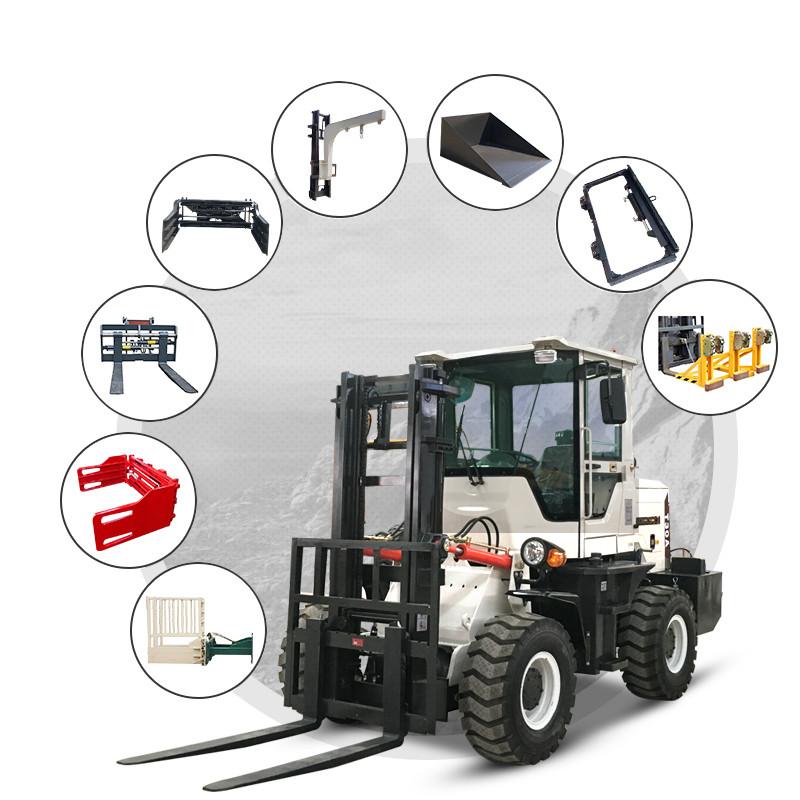As an important branch of special forklifts, off - road forklifts are composed of engines, chassis, working devices, and electrical equipment. They adopt a full - wheel drive system without a differential between axles, and are equipped with large - diameter wide - base semi - steel tires to ensure passability in complex terrains such as mud and mountains. The articulated frame design allows a swing angle of ±30° - 40°. Together with the hydraulic support system that enables the front axle to swing vertically, it can accurately align the fork with materials and improve driving smoothness. A larger wheelbase and track enhance lateral and longitudinal stability. With a speed of 30 - 40 km/h, they have both mobility and climbing ability.

Compared with ordinary forklifts that are limited to working on flat roads, off - road forklifts have full - time four - wheel drive, high ground clearance (usually over 300 mm), and a strengthened suspension system, allowing them to operate stably in harsh environments such as slopes, sand, and snow. They have more powerful engines, use disc or wet brakes, and mainly use hand brakes for parking, adapting to heavy - load working conditions. In addition, off - road forklifts support fork adjustment and quick attachment replacement to meet the handling needs of irregular goods. Ordinary forklifts can only perform vertical lifting operations, with obviously limited application scenarios.
- Power and Drive System: Equipped with high - horsepower engines, matched with various walking systems such as mechanical transmission, hydraulic transmission, or hydrostatic transmission. Using the full - power matching method to optimize the full - load climbing performance, they have sufficient power reserves.
- Chassis and Suspension Technology: The axle design with a fixed rear axle and a hydraulically swinging front axle, combined with a vertical swing amplitude of ±8° - 12°, ensures that all four wheels are always in contact with the ground to reduce slipping. The frame swing angle, together with a small turning radius, improves flexibility in narrow spaces.
- Braking and Safety Design: The full - wheel braking system is standard with disc brakes, and large - tonnage models use wet brakes for stable braking performance. The driver's seat is arranged forward, and with a wide - angle vision design, it reduces the risk of blind spots during operations.
By quickly replacing attachments such as forks, buckets, booms, and clamps, off - road forklifts can perform multiple functions such as material handling, stacking, lifting, and grabbing. For example, in agriculture, they can carry straw with bale clamps; in mining, they can handle rough stones with stone forks; and in ports and docks, they can complete heavy - load handling with container spreaders. The multi - function of one machine significantly improves work efficiency and reduces equipment procurement costs.
In construction sites, mining areas, logistics parks, and other scenarios, off - road forklifts, with their strong carrying capacity (e.g., 6 - ton models can easily lift palletized heavy objects) and terrain adaptability, undertake tasks such as building material transportation, ore handling, and warehouse stacking. Their extensions such as extended forks and stabilizers can handle extra - long and extra - heavy goods, solving the handling needs that ordinary forklifts cannot meet. Especially on unhardened roads or temporary construction sites, they become core equipment for efficiency assurance.
In fields, forestry mountains, off - road forklifts can be competent for crop transportation, agricultural machinery handling, seedling transplantation, and other work. The high - chassis design avoids chassis collisions, and off - road tires provide strong grip, allowing stable driving even on muddy plots after rain. For example, loading container - type fruit baskets in orchards, carrying silage feed piles in pastures, or transporting logs in forest farms, their passability and mobility are significantly better than traditional agricultural machinery, becoming an important supplement to modern agricultural mechanization. In emergency scenarios such as disaster relief and military logistics, off - road forklifts can quickly load and unload materials in harsh terrains such as ruins, beaches, and snow, and complete equipment towing tasks with traction devices. Their full - wheel drive and differential lock configurations ensure no slipping on soft or icy roads, providing key transportation support for emergency rescue and demonstrating far better environmental adaptability and task reliability than ordinary forklifts.






